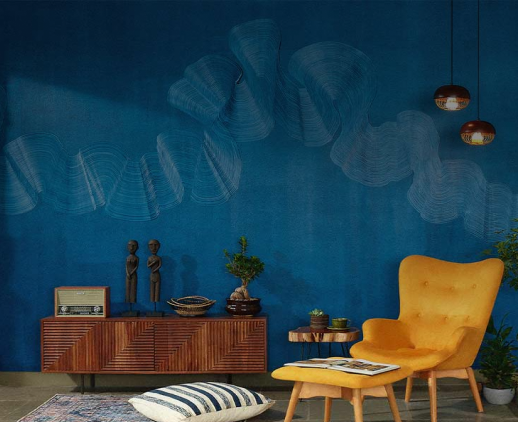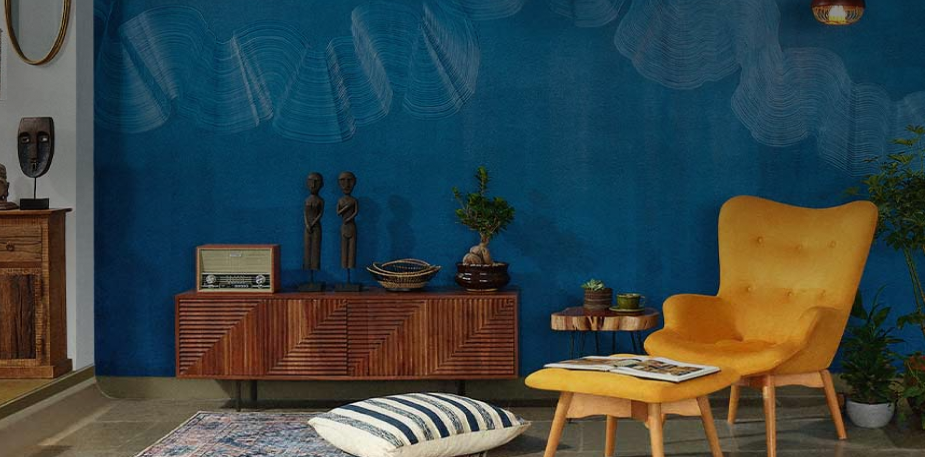Get your home interior design budget estimate
This Mumbai apartment brings home the Japanese philosophy of Ikigai

Designed by Nishita Kamdar, this three-bedroom home is inspired by the hues of sand that create a warm, lived-in oasis
The hustle-bustle of Mumbai city comes to a standstill as you enter through the oak veneer clad main door of this 950-square-foot apartment in Vikhroli. With a view of lush mangroves, this home on the first floor of a high-rise is hugged by tall trees that play hide-and-seek with the sunlight. As some filters in through the sheer linen curtains, it creates a magical display in each room. Principal architect Nishita Kamdar of her eponymous studio worked her magic on the interiors of this three-bedroom apartment. Taking inspiration from nature, the hues used in this home are inspired by the varying shades of sand ranging from light beige to dark beige, to sometimes yellow, salmon and even orange. “One of the beautiful things about art, architecture and design is their ability to reflect the things we see and experience around us. Our travels, thoughts, inspirations and encounters always find a way to wiggle into our designs in the most discreet way. The overriding design concept here is to envelope the otherwise small home in the lovely colours of sand,” she explains.
Living Spaces
A salmon pink couch lies adjacent to the living room wall, flanked by two Chandigarh-style chairs, a hand-dyed rug, with a custom-made live edge centre table. The room opens out to a small balcony filled with potted plants, some of them making their way indoors too. As one moves to the dining area, the long passage is clad in a panelling inspired by the Japanese shoji screen pattern of thin tendril-like teakwood verticals and black metal horizontal battens. “The idea here was to discreetly hide the several doors and storage spaces along that wall, thus giving an illusion of connectivity and adding length to the otherwise broken space,” reveals Kamdar.

The glass bookshelf showcases their collection and passion for reading.
Continuing with the practical design approach, the dining table from Sar Studio is a simple marble top with handcrafted dining chairs made of teakwood and cane. On the other side, a custom-made dining bench fitted to the wall creates the illusion of space.
Behind, a glass and black metal bookcase stands tall, showcasing the owners’ love for reading, and displaying their book collection in full view. The mother and daughter who live here, are avid readers and wanted enough space for their prized collection.
The kitchen is concealed behind the shoji screen along the passage wall and opens up from the centre, as a shoji screen would, to give a full view of the olive green and wood-clad kitchen space.
A Sandy Desert
The mother’s bedroom features a hand-carved oakwood headboard that extends across the wall with an oval mirror added for visual appeal. There’s also a matching console table on the opposite side with knick-knacks and floral décor. Next to the bed is a custom-designed totem-like standing floor lamp with a hemp fabric shade. The design team made it using offcuts from the plywood used on site as an experiment to reuse waste. Know plywood vs mdf what is best material for your home.
In the daughter’s bedroom, the décor screams modern minimalistic with a low metal bed, a black metal bookshelf, and a cane wardrobe. Geometric side tables and table-mounted artwork make the space look informal and cosy. Tones of purple yam headboard and tangerine bedding blend in effortlessly with the warm sand walls.

The dining area features a bench on one side.

The home is done up in hues of sand.
The guest bedroom features floor-length French windows that offer unobstructed views of the garden below. A sleek wooden sofa-cum-bed with plush cushions, a black burnt wood shelf and study desk filled with curios from all around the world make this room ideal for some downtime.
The desert often invokes a sense of vastness, infinity, an ever-changing landscape and uncertainty which can be intriguing. “We interpreted sand as a force that brings about a visual serenity in the home as it does in a desert. The ever-changing nature of the shifting of sand, like in this home, makes a space which could be flexible and changing with time. The soft beige tone of the sand almost blends with human skin tone and neutralises everything—it doesn't fight to stand out, it lets the heroes stand out,” concludes Kamdar.

Get Started with your interior design journey with us!
Speak to our design professionals
What’s the status of your home possession?
What’s the condition of your home/space?
Will you be living in your space during the renovation?
 Previous Question
Previous Question
Is your interior design budget over 4 lakhs?
 Previous Question
Previous Question
Book next available appointment slots with our experts!
Please Select Date and Day
 Previous Question
Previous Question

Something went wrong!
We were unable to receive your details. Please try submitting them again.

Appointment Scheduled!
Thank you for giving an opportunity to Asian Paints Beautiful Homes Service! Our Customer Experience Specialist will get in touch with you soon.
Appointment Date & time
Thank You!
Our team will contact you for further details.
What’s the status of your home possession?
What’s the condition of your home/space?
Will you be living in your space during the renovation ?
 Previous Question
Previous Question
Is your interior design budget over 4 lakhs?
 Previous Question
Previous Question
Book next available appointment slots with our experts!
DEC 2023
Please Select Date and Day
 Previous Question
Previous Question

Something went wrong!
We were unable to receive your details. Please try submitting them again.

Appointment Scheduled!
Thank you for giving an opportunity to Asian Paints Beautiful Homes Service! Our Customer Experience Specialist will get in touch with you soon.
Appointment Date & time
17 Oct 23, 03.00PM - 04.00PM















































